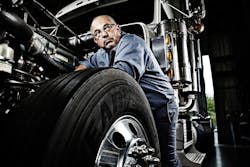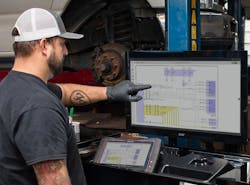Truck technicians and tools must meet modern demands
In our fast-paced world where information is just a click away, the new generation of aspiring truck technicians might struggle with the idea of spending unproductive time flipping through a stack of manuals to fix a truck. If wading through a greasy book stack is what the job requires, those technicians may simply move on to a more technology-centric position somewhere else.
However, as technology continues to advance, it’s imperative to have the these technology-minded technicians—and a sufficient number of them—in order to meet the repair requirements demanded by today’s modern commercial truck industry.
Your customers, both now and in the future, expect your shop to be fully equipped to diagnose and fix these vehicles right the first time. The goal is to get them back on the road as quickly as possible because every vehicle that rolls into your shop needs to get back to work pronto. And more often, modern truck repairers are finding that digital alternatives to traditional shop methods improve fleet uptime and technician productivity.
The Challenge of modern truck repair
One thing to remember is that today’s trucks are significantly different from those that past generations operated or repaired. With advanced safety and technology features, they have become much more complex in the last 10 to 20 years. It’s rare for technicians, even those with extensive experience, to know everything about servicing every truck in existence.
Techs themselves are also becoming more rare. It’s no secret that there has been a shortage of technicians affecting not just this industry. That also has a major impact on the entire economy, which relies heavily on the productivity of commercial vehicles. Therefore, it is the responsibility of employers to build and maintain a satisfactory pool of skilled technicians to keep those vehicles moving.
The importance of modern tools
Truck repair provider W.W. Williams understands how important its technicians are to keeping its geographically dispersed customer base satisfied and returning for future repair needs.
“It’s essential to incorporate web- or cloud-based diagnostic and repair tools into shop operations. These tools have become imperative in this modern age, not only to support recruitment efforts but also to provide technicians with updated information that is easily accessible,” said Rich Whiteley, vice president of operational development/integration, during a recent interview with Mitchell 1 staff.
The discussion further delved into the common challenge faced by truck repair sites in maintaining their technician employment numbers. Whiteley stressed that not only do recruited technicians expect these tools to be available, but they are also vital for effectively diagnosing and repairing vehicles on a daily basis.
Additionally, shops should consider that technicians today have an abundance of employment options with the freedom to choose workplaces offering better pay and optimal working conditions. This preference extends to modern shops that are equipped with both physical tools and information/software tools, as technicians recognize the value of working in an environment that is up-to-date and provides them with the necessary resources to be confident in efficient repairs.
Incorporating RPs for efficiency
Mitchell 1’s online TruckSeries maintenance software—utilized in all 25 of W.W. Williams’ truck repair locations across the U.S.—has recently integrated ATA’s Technology & Maintenance Council’s (TMC) Recommended Practices (RPs). This allows TruckSeries users to effortlessly locate the most suitable RP for the specific task at hand, thanks to the platform's user-friendly and efficient search functionality. The best part is that it is quick and intuitive - meeting the expectations of the younger generation of technicians.
Read more: Mitchell 1 TruckSeries gets TMC RPs and more user-friendly wiring diagrams
This inclusion of Recommended Practices (RPs) in WW Williams' operations provides their technicians with a deeper understanding of the tasks they perform. For instance, instead of merely replacing a burnt-out light bulb, the RPs enable technicians to identify the underlying cause of the issue.
By addressing and fixing the root cause, they can prevent recurrence, thus eliminating the need for the truck to return for a similar issue. Whiteley expressed his satisfaction with this valuable information, acknowledging that it gives W.W. Williams an advantage over their competition in terms of repair efficiency and technician satisfaction.
Kristy Coffman is responsible for overseeing all aspects of Mitchell 1's commercial vehicle product line, including TruckSeries repair information software and Manager SE Truck Edition shop management system for Classes 4-8 trucks.
About the Author

Kristy Coffman
Kristy Coffman serves as the Director of the Commercial Vehicle Group at Mitchell 1, the leading shop management and repair information systems provider in the automotive aftermarket. In her current role, she oversees all aspects of the commercial vehicle product line, including TruckSeries repair information software and Manager SE Truck Edition shop management system tailored for Class 4-8 trucks.
With a tenure dating back to 1997, Kristy initially joined Mitchell 1 as a customer service agent and has since navigated through various roles and responsibilities within the organization. Her journey has seen her take on pivotal positions such as product owner and manager, where she spearheaded software development initiatives and managed successful product launches.
In 2006, Kristy transitioned to associate product manager within the Commercial Vehicle Group, where her passion for the trucking industry flourished. Her core mission centers on developing and delivering products that empower technicians and shop owners to achieve success.
Kristy's professional background also includes significant roles at Maxwell Technologies, a global leader in energy storage and power delivery solutions for automotive and heavy transportation applications. Here, she served as a Fleet Sales Specialist and Senior Global Sales Planning Specialist, further expanding her expertise within the automotive technology sector.

